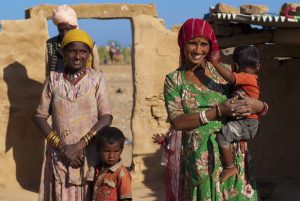
The proportion of women in India’s national assembly reached 14% in 2023, the highest number since the country’s independence. Female leaders have multiple societal benefits, but their net impact also depends on prevailing cultural norms. Credit: Sumitsaraswat09|Dreamstime.com.
The growing number of female lawmakers in much of the world has raised the aspirations and career goals of adolescent girls. Beyond serving as role models, female leaders have also helped expand public goods and services and reduced maternal mortality during and after childbirth.
But in some countries, the election of female leaders may collide with cultural norms to cause an unintended backlash. “A greater number of female leaders has been associated with a rise of conflicts at home in Brazil and an increase in police-reported crimes against women in India,” says AAE assistant professor Priya Mukherjee.
These and other findings prompted Mukherjee and her colleagues at the World Bank and Northeastern University to explore the effect of newly elected female leaders on village healthcare facilities and marriage dynamics in rural India. They identified easier access to primary and reproductive healthcare services as benefits—but the greater ability of women to make their own family planning decisions also increased reports of spousal abuse, especially when husbands wanted more sons than their wives.
The analysis started with combining three distinct datasets. The first came from the Election Commission of India and included parliamentary election outcomes in 36 states and union territories, comparable to the 50 states in U.S. elections. Indian states contain multiple electoral districts—similar to U.S. counties—with multiple constituencies (bodies of voters) per district. For each constituency, the gender and number of received votes were available for all candidates who ran for office.
The second dataset was a District-Level Household and Facility Survey with public health infrastructure information reported in 2012-13 by 8,300 village leaders from 22 rural states. The researchers assigned each village to one of 265 electoral districts to combine the infrastructure data with the fraction of seats won by women in the most recent state election.
The third dataset was a National Family Health Survey with demographic, educational and occupational data reported in 2015-16 by more than 60,000 married women (ages 15 to 49 years) and men (ages 15 to 54 years) living in rural areas. This was a representative sample of 70% of India’s population. A subset of women also responded to a domestic violence survey provided data on physical, psychological and sexual abuse at home. The researchers assigned each residential address to one of 626 electoral districts to combine the survey data with the fraction of seats won by women in the most recent state election.
Using survey data to identify causal effects of female leaders is challenging because both the probability of female candidates running for office and of voters electing them depend on many unobservable factors. For example, attitudes about gender roles, the accessibility of polling stations and relative experience levels of candidates differ between voting areas, and ignoring these differences would produce invalid results.
The ideal solution would be to randomly assign female or male leaders to all constituencies and observe the outcome of interest. This randomized experiment would ensure that the elected official’s gender is the only difference between the two groups.
Since such an experiment is not feasible, the researchers focused instead on a subset of elections where a female leader was almost randomly determined: close elections, defined as a margin of victory of less than three percentage points, where the winner and runner-up were of opposite gender. As in a randomized design, places where women did or did not win these close elections were very similar except for the winner’s gender.
The researchers used a clever statistical trick, known as instrumental variable estimation, to build these almost-random election outcomes into their analysis in order to assess causal effects of female leaders. In the 8,300 villages, newly elected female lawmakers increased the number of rural community health centers and women’s health specialists. This improved access to medical services resulted in a greater use of modern contraceptives and a greater spacing between births in rural women—but it also caused more women to experience physical violence by their husbands.

Additional analyses showed that spousal abuse was most common in women whose husbands wanted more sons than they currently had. This suggests that a greater use of modern contraceptives may lead to backlash from aggrieved husbands in countries with low levels of female empowerment and strong beliefs in traditional gender roles. The data did not support other potential explanations, such as men not wanting their wives to work or women being more likely to report abusive husbands.
“Focusing on the impact of female leaders on the personal lives of Indian women is a unique aspect of our study,” says Mukherjee. “Documenting this backlash is a first step toward efforts to address and prevent it, especially now that India is rolling out a quota system to fill one-third of seats in national and state parliaments with women.”
Mitigation could start with training medical providers to recognize victims of domestic abuse. Ideally, providers would then direct these victims to shelters, hotlines, support groups and programs offering case management and legal advocacy services.
“These programs and services have yet to reach India, where patriarchal norms continue to be widespread,” says Mukherjee. “They are urgently needed because domestic abuse is the most common form of violence experienced by Indian women and exacts an enormous toll on both their health and their ability to pursue career and economic opportunities.”